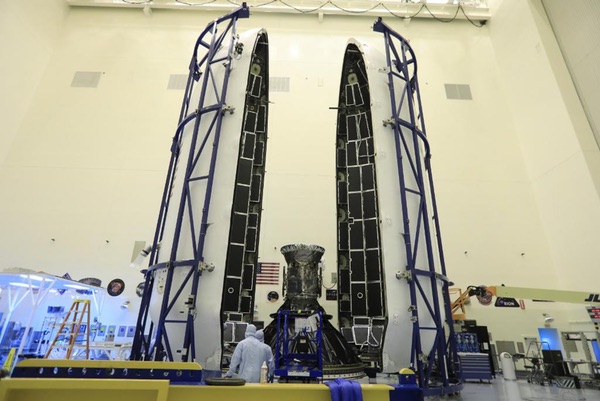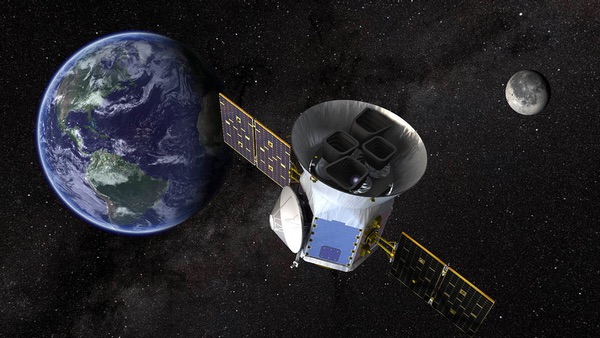The next era in exoplanet searchesby Jeff Foust
|
| “TESS is tiny, but it punches above its weight,” Ricker said. |
Kepler, though, is nearing an end as it runs out of fuel for its thrusters. As the Kepler mission approaches its inevitable conclusion, astronomers have now turned their attention to the next generation in exoplanet searches. A SpaceX Falcon 9 is scheduled to launch this week NASA’s Transiting Exoplanet Survey Satellite, or TESS, mission (the launch, which was scheduled for Monday, was delayed a few hours before liftoff until no earlier than Wednesday to address a guidance, navigation and control issue with the rocket.)
TESS, as it names suggests, uses the same approach as Kepler to discover exoplanets, searching for those telltale brightness dips that are the signature of worlds orbiting other stars. But while Kepler’s original mission was to look at a single area of the sky, TESS instead will perform an all-sky survey, focusing primarily on nearly, bright stars that are ideal targets for follow-up observations by large groundbased and future spacebased telescopes like the James Webb Space Telescope.
“It’s a finder scope for JWST,” said George Ricker, principal investigator for TESS, at a meeting of the American Astronomical Society in suburban Washington, DC in January. Just a small finder scope helps astronomers find a target for a larger telescope, TESS will do the same for JWST and other observatories.
The finder scope analogy also applies to their relative sizes—and costs. While JWST is a massive spacecraft with a 6.5-meter primary mirror, and with its latest delays is widely expected to bust its $8 billion cost cap for development, TESS and its instrument suite of four small wide-field cameras weighs in at about 360 kilograms, with a mission cost of about $300 million, including launch. The spacecraft looked particularly tiny last week as it was being encapsulated in the Falcon 9’s payload fairing, sized for far larger satellites.
“TESS is tiny, but it punches above its weight,” Ricker said.
 The TESS spacecraft being encapsulated in the Falcon 9 payload fairing—sized for much larger spacecraft—last week. (credit: NASA) |
The launch of TESS is not much different from a Falcon 9 mission for a commercial communications satellite, with two burns of the rocket’s upper stage to place the spacecraft into a highly elliptical transfer orbit. “It looks like a GEO transfer orbit, but going further out towards the Moon,” said Hans Koenigsmann, vice president of build and flight reliability at SpaceX, at a pre-launch press conference April 15.
Released from the upper stage nearly 49 minutes after liftoff, TESS will perform a series of maneuvers to extend its orbit, setting up for a lunar flyby scheduled for mid-May. “We have to do apogee burns and perigee burns for four or five orbits” after satellite release, said Jeff Volosin, TESS project manager at NASA’s Goddard Space Flight Center, at that press conference. “That lunar flyby timing that’s going to put us into that [final] orbit.”
If all goes well, TESS will enter that final orbit, known as a P/2 resonance orbit, in mid-June. That orbit puts the spacecraft into a stable 2:1 resonance with the Moon, minimizing the stationkeeping maneuvers needed while also allowing for high data rates to transmit data back to the Earth, unlike Kepler’s heliocentric orbit that has it drifting further from the Earth.
| “Our current estimates are that Kepler’s tank will run dry within several months—but we’ve been surprised by its performance before!” said Sobeck. |
While TESS has a two-year prime mission, the stability of its orbit could allow for significant extensions if the rest of the spacecraft is performing well. “The operational life of the mission could very well extend for more than two decades,” Ricker said in January.
TESS’s primary mission will be exoplanet searches, but as with Kepler—whose data has been used for a wide variety of other astrophysical research—mission officials anticipate additional uses of the data, such as stellar astrophysics and extragalactic astronomy. A guess investigator program run by NASA will support those additional lines of research.
TESS did have some issues during its development, notably with its optics. Last summer, NASA acknowledged that they had discovered the focus of the cameras would drift slightly as they cooled after launch. While the agency downplayed the issue, some astronomers worried that it would prevent the mission from meeting some of its science goals.
Ricker and other project scientists are more confident now that the focus drift won’t be a problem. “Subsequent testing that we did starting this summer and then into the fall indicated that there is a model” for explaining the drift, he said in January. That model concluded there is a “very reproducible crystallization effect” in one of the materials used in the cameras that causes the drift. That drift stops after time, and Ricker called it a one-time “focus shift” rather than a “focus drift,” which sounds more continuous.
Because TESS is primarily a photometry mission, measuring the brightness of the stars, the focus drift—or focus shift—won’t affect mission science, Ricker argued at the January conference.
“This is a photometry mission, not an imaging mission,” he said. “What this means is that it’s not important to have a sharp focus across the entire field of view. This was never part of the design. But it is important that the focus be stable, and that’s what we’ve been able to establish.”
The launch of TESS comes as Kepler reaches the end of its life. The spacecraft is running out of propellant used by its thrusters to maintain its attitude since the failure of two of its reaction control wheels several years ago. When that propellant is exhausted, the spacecraft’s mission will come to an end, as it will no longer be able to control its pointing.
A NASA statement in March about the end-of-mission plans led some to conclude that Kepler’s demise is imminent. But without a fuel gauge, spacecraft operators are relying on their best estimates of how much propellant is left, with some margin for error.
“Our current estimates are that Kepler’s tank will run dry within several months—but we’ve been surprised by its performance before!” Charlie Sobeck, system engineer for Kepler, said in that statement. “So, while we anticipate flight operations ending soon, we are prepared to continue as long as the fuel allows.”
The spacecraft itself is operating well other than the low fuel, so scientists are working to squeeze as much science out of it as possible. Plans are in place for additional campaigns that would run through the rest of this year.
| “TESS forms kind of a bridge between what we’ve learned about exoplanets to date and where we’re headed in the future,” said Volosin. |
Data collected by Kepler is still being mined by astronomers for new exoplanet discoveries and other research, a process that will continue long after Kepler ends. “While we’re running low on fuel,” Jessie Dotson, K2 project scientist at NASA’s Ames Research Center, said in January, “the science is just getting going.”
TESS is being billed by NASA as a successor sorts to Kepler, continuing the hint for exoplanets and finding targets for later missions. “TESS forms kind of a bridge between what we’ve learned about exoplanets to date and where we’re headed in the future,” said Volosin. “That’s a big part of our mission: to enable future exploration by providing a giant dataset all over the sky of where these exoplanets are.”
Those discoveries themselves should be exciting, based on the public reaction to Kepler’s haul of exoplanets. Robert Lockwood, the program manager for TESS at Orbital ATK, which built the spacecraft, said his wife, who doesn’t work in the field, was particularly excited about this mission, citing the “extraordinary stuff” it will do finding new worlds.
“The idea of finding other things on other planets really just sparks something in people,” he said at the pre-launch press conference. “I think it will catch on like wildfire… TESS is going to bring that to another level.”
